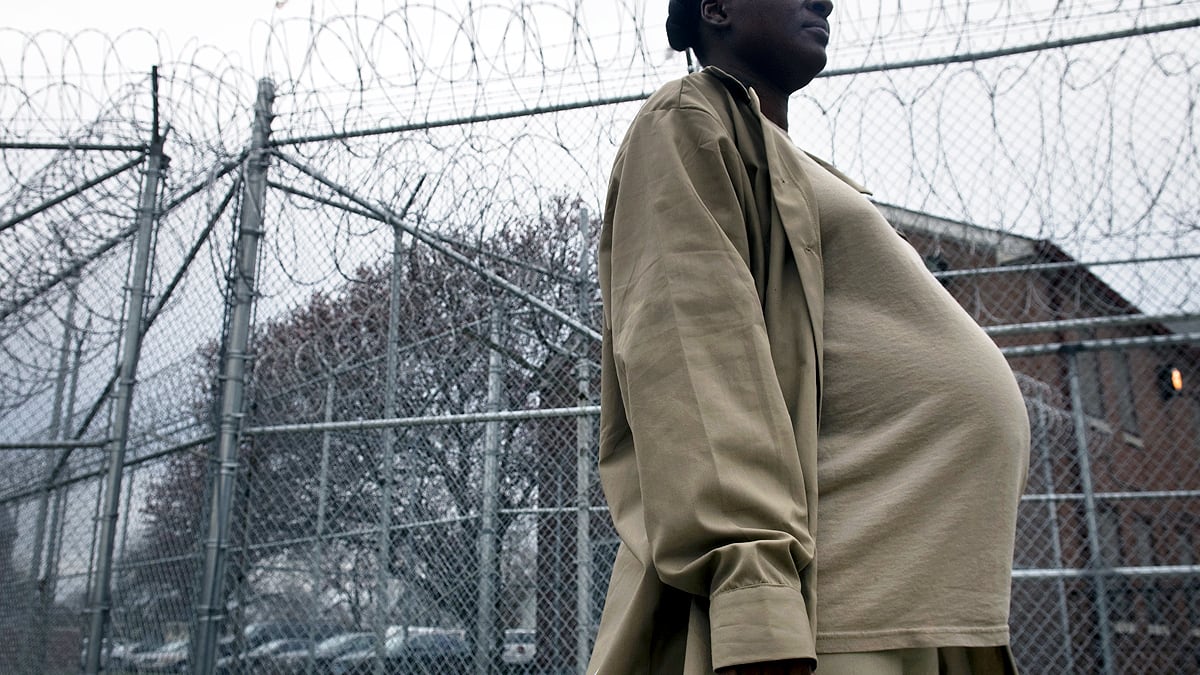From the moment her daughter was born, Kellie Phelan, 37, felt like an embarrassment. It wasn’t that she’d hid her pregnancy from her family, or even that she spent part of it behind bars at Rikers Island. Rather, Phelan was mortified by the metal cuff that bound her leg to her bed during labor at New York’s Elmhurst Hospital—the same cuff that shackled her swollen ankles together during the ambulance ride over.
Phelan’s experience is not unique. In 36 states, it is legal to shackle pregnant inmates during labor and not uncommon to cuff a woman’s limbs to a hospital bed until delivery. Due to health risks to both mother and child, however, a growing number of states are banning the practice with anti-shackling bills.
This year alone, 16 states introduced bills that would restrict the use of restraints on pregnant prisoners at varying points perinatally. Of those states, Hawaii, Idaho, Rhode Island, and Nevada passed bills to join the ranks of 10 others that, at the very least, ban shackling during labor (a ban already exists in federal prisons). And, most recently, a woman in Tennessee was awarded $200,000 after she sued the state for being shackled when she went into labor shortly after she was arrested for driving without a license.
According to Malika Saada Saar, founder and executive director of the Rebecca Project for Human Rights, little data exists on babies born to incarcerated mothers—yet the Women’s Prison Association reported that 4 percent of women in state prisons and 3 percent of women in federal prisons were pregnant when they were jailed in 2004. Since 1980, the number of incarcerated women in the U.S. has increased eightfold, from 12,300 to more than 180,000, according to the ACLU.
Phelan counts herself among the women locked up as a result of America’s war on drugs, which is largely responsible for the spike in female prisoners. “When I was seven months pregnant, every day [it was] crack cocaine. I was smoking crack. From the second she was conceived, I put her through hell,” Phelan said of her daughter, Savannah Grace, who is now 4 years old.

Shackling refers to the use of restraints anywhere on a pregnant prisoner’s body, from binding her hands and feet to chaining her abdomen. Pregnant prisoners’ arms and legs are usually shackled with metal handcuffs during transportation, then cuffed directly to their hospital bed by an arm and a leg in the delivery room. The American Congress of Obstetricians and Gynecologists, the American Medical Association, and the United Nations have condemned the practice, citing the serious health risks posed to mother and infant. Eli Adashi, a professor of medical science at Brown University and member of the Center for Prisoner Health and Human Rights, said these risks grow with each advancing stage of pregnancy. During the inevitable transportation between a prison and medical facility, merely walking while shackled could lead to a fall due to changes in balance and weight.
When Rachel Sutton, 28, was transported from Ohio to New York while six months pregnant in 2009, both her hands and feet were cuffed for the duration of the five-and-a-half-hour trip. During a stop at a gas station, one hand was uncuffed while Sutton used the bathroom. “I could barely walk,” Sutton, who was incarcerated for criminal sales of a controlled substance, told The Daily Beast. “They had to keep stopping because I was out of breath, first of all, because I was huge and I couldn’t even really walk in shackles because they were so small.”
The challenges of shackling become more urgent in the delivery room, where it’s vital for a woman to move around early in labor to appease pain and expedite delivery. Should an emergency arise, including the need for a cesarean section, precious seconds are lost uncuffing a woman, potentially preventing a doctor from delivering necessary care, said Maureen Phipps, associate professor of obstetrics and gynecology at Brown University.
“Anyone who has had a baby knows it’s almost impossible to sit still. So, depending on how the woman is shackled, it’s incredibly debilitating. If her feet are shackled—if she’s forced to stay on her back, it can put stress on the baby’s heart,” said Tina Cassidy, a maternal-health advocate and author of Birth: The Surprising History of How We Are Born.
Beyond the physical burden, shackles double as a scarlet letter. When Phelan visited her newborn daughter after giving birth, she walked through the hospital hallway with her feet cuffed together, clad in an orange jumpsuit emblazoned with the Department of Corrections insignia. “Here are all these proud parents with their babies looking at me like I’m a convict,” she said (which, to be fair, she was at the time). “Here I am looking at Savannah like this is a miracle, looking like I’m saved but so sad.”
When Phelan, who also has an older daughter, returned to Rikers two days later, she was placed in the bullpen, a cell for multiple inmates. She sat on the floor of the cell because the beds were taken until the other inmates learned she’d just given birth.
Indeed, the aftermath of giving birth while incarcerated can prove just as damaging to mothers and infants. If a prisoner’s hands are restrained following delivery, it can be difficult for her to breastfeed or even hold her baby, which can stand in the way of crucial postpartum bonding. Georgia Lerner, executive director of the Women’s Prison Association, said she believes treating women this way is akin to handling cattle. “What we’re really doing is reinforcing that person’s powerlessness in the situation,” she said. “I don’t think people are aware that that’s what they’re doing—that they’re dehumanizing someone in such a profound way.”
So given all the evidence against it, why shackle women at all?
Historically, pregnant prisoners have been restrained out of a fear that they could flee or harm others if uncuffed—an argument many doctors and advocacy organizations brush off. “I’m sure you can create your own visual about a woman eight centimeters dilated and in labor. The chances of her getting up and running away are pretty slim,” said Jeanne Conry, a district chair of American Congress of Obstetricians and Gynecologists.
Even so, shackles aren’t prison officials’ only line of defense. If an inmate were to attempt an escape when unshackled, she’d have to contend with the officers guarding—and often inside—the delivery room. And some women give birth in high-security prison wards within hospitals.
Until recently, the reproductive-health care of incarcerated women has been overlooked, because prisons have traditionally been structured with the needs of a male incarcerated person in mind, said Tamar Kraft-Stolar, director of the Women in Prison Project at the Correctional Association of New York. In turn, most women—violent and nonviolent offenders alike—end up with security measures more appropriate for “Hannibal Lecter,” in the words of Gail T. Smith, executive director of Chicago Legal Advocacy for Incarcerated Mothers.
Though anti-shackling legislation is gaining traction across the country, with Hawaii and Rhode Island passing bills this summer, corrections departments resist laws that limit the practice. The Association of State Correctional Administrators responded to the crackdown with a resolution stating that anti-shackling legislation unnecessarily inhibits officers from applying “professional expertise,” should unanticipated circumstances arise where restraints are necessary. The organization says it supports shackling “only when absolutely necessary.”
The bills themselves carry varying implications, depending on the state. California, Colorado, Hawaii, Idaho, Illinois, New Mexico, New York, Nevada, Pennsylvania, Rhode Island, Texas, Vermont, Washington, and West Virginia all prohibit shackling during delivery, while some extend the ban to include transportation and labor. As state governments continue to consider legislation, some experts say an ideal bill would ban the practice from the moment a prisoner learns she’s pregnant to eliminate any possible health risks.
Enforcement of the laws, of course, is another challenge entirely. Last year inmates in Chicago sued the Cook County sheriff’s department for shackling them despite a ban, while other states have faced suits similar to the recent case in Tennessee.
For now, Cassidy advocates for correctional institutions to use pregnancy as a positive opportunity for new mothers to change their lives, rather than an opportunity for pain and embarrassment.
Phelan certainly has. Today, she oversees a mentoring program for children of incarcerated parents at Hour Children, a community-reentry organization for women in New York City. “Part of the reason her name was Savannah Grace was because she was like my saving grace,” she said. “I knew I found my way out and there was no turning back.”





